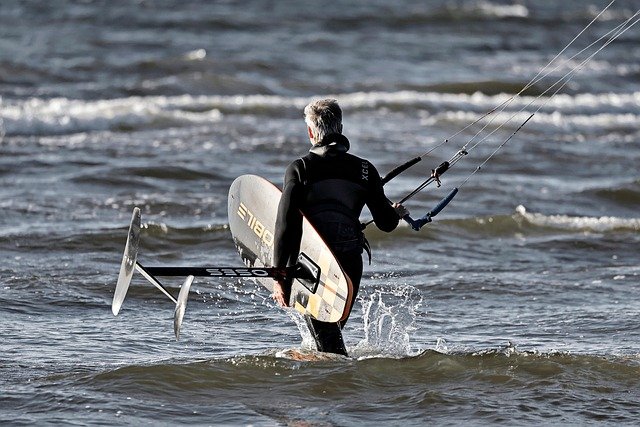Kite Foiling: Riding the Wind on Water
Soaring above the waves, propelled by wind and skill, kite foiling represents the cutting edge of water sports innovation. This exhilarating fusion of kitesurfing and hydrofoiling has captured the imagination of thrill-seekers and competitive athletes alike. As boards seemingly levitate above the water's surface, riders harness the power of wind and hydrodynamics to achieve unprecedented speeds and maneuverability.

The hydrofoil, a wing-like structure mounted beneath the board, creates lift as it moves through water, allowing the board to rise above the surface. This principle, borrowed from nautical and aeronautical engineering, drastically reduces drag and increases efficiency. When combined with the power of a kite, it enables riders to achieve remarkable speeds and perform in lighter wind conditions than traditional kiteboarding.
Early pioneers of kite foiling faced numerous challenges. The equipment was unstable and difficult to control, requiring a steep learning curve even for experienced kiteboarders. However, as designs improved and riders developed new techniques, kite foiling began to gain traction in the watersports community.
The Physics Behind the Flight
At the heart of kite foiling lies a complex interplay of forces. The kite, manipulated by the rider through a control bar, harnesses the wind’s energy to provide forward propulsion and lift. This force is transferred through lines to the rider and the board.
The hydrofoil itself consists of a mast, fuselage, and wings. As the foil moves through water, the wings create a pressure differential, with lower pressure on top and higher pressure underneath. This difference generates lift, much like an airplane wing in air. Once sufficient speed is achieved, typically around 6-8 knots, the lift force overcomes the weight of the rider and board, causing them to rise above the water.
The physics of foiling allows riders to achieve higher speeds with less effort compared to traditional kiteboarding. By eliminating the drag caused by the board’s contact with choppy water, kite foilers can maintain their speed more easily and ride in winds as light as 8-10 knots – conditions that would leave traditional kiteboarders struggling to get planing.
Equipment Evolution and Innovation
The rapid advancement of kite foiling owes much to continuous innovation in equipment design. Early foils were often adapted from windsurf hydrofoils, but as the sport grew, manufacturers began developing purpose-built kite foiling equipment.
Modern kite foils are typically constructed from carbon fiber or aluminum, offering a balance of strength, weight, and performance. The foil’s design has been refined to provide better stability, lift, and speed characteristics. Some advanced foils even feature modular systems, allowing riders to swap out components to suit different conditions or riding styles.
Boards have also evolved significantly. Initially, riders used modified surfboards or custom shapes. Today, dedicated kite foil boards are shorter and more compact than traditional kiteboards, with specific features to accommodate the foil mounting system and the unique dynamics of foil riding.
Kites used in foiling have seen their own evolution. While standard kiteboarding kites can be used, many manufacturers now offer kites optimized for foiling. These tend to have better low-end power and more stable flight characteristics, allowing riders to maintain consistent power even in variable wind conditions.
Riding Techniques and Skills
Mastering kite foiling requires a unique set of skills that blend elements of kiteboarding, surfing, and even flying. The most critical skill is balance – riders must learn to manage their weight distribution precisely to control the foil’s lift and direction.
Takeoff, or “pumping” onto the foil, is one of the first challenges new riders face. This involves using a combination of kite power and board movement to generate enough speed for the foil to create lift. Once foiling, riders must constantly adjust their body position and kite control to maintain stability and direction.
Turning on a foil introduces new dynamics compared to traditional kiteboarding. Riders must learn to carve smoothly, using a combination of body weight shifts and subtle kite movements. Advanced riders can perform tacks and jibes without touching the water, a maneuver known as a “foil-to-foil” transition.
One of the most exhilarating aspects of kite foiling is the ability to ride swells and waves. Unlike traditional kitesurfing, where riders often need to use the kite’s power to catch waves, foilers can use the foil’s efficiency to ride swells with minimal kite input, creating a sensation akin to endless wave riding.
Competition and Performance Frontiers
As kite foiling has matured, competitive scenes have emerged, pushing the boundaries of what’s possible on a hydrofoil. Racing has become particularly popular, with kite foilers achieving speeds that rival or exceed those of traditional sailing craft.
The Formula Kite class, which uses hydrofoils, has been selected as the equipment for kiteboarding’s Olympic debut, scheduled for the 2024 Paris Olympics. This has led to increased investment in equipment development and athlete training programs worldwide.
Beyond racing, freestyle kite foiling has opened up new possibilities for tricks and maneuvers. Riders are exploring new ways to combine altitude, speed, and control, performing jumps, rotations, and even flips while maintaining contact with the foil.
Long-distance foiling has also gained popularity, with riders taking advantage of the foil’s efficiency to cover impressive distances. Some adventurers have even undertaken multi-day expeditions, foiling between islands or along coastlines, showcasing the potential for exploration and adventure in this discipline.
Environmental and Accessibility Considerations
Kite foiling’s ability to perform in lighter winds and various water conditions has opened up new possibilities for the sport’s growth. Areas with marginal wind conditions for traditional kiteboarding can now support foiling communities, potentially reducing the need for travel and its associated environmental impact.
The sport’s efficiency also means that riders can spend more time on the water with less physical exertion, making it accessible to a broader range of ages and fitness levels. However, the initial learning curve and equipment costs can be barriers to entry for some.
From an environmental perspective, kite foiling’s minimal impact on marine ecosystems is noteworthy. The foil’s design means there’s less interaction with the water’s surface, reducing the potential for disturbance to shallow water habitats or wildlife.
Safety and Training
While kite foiling offers exciting possibilities, it also presents unique safety challenges. The combination of speed, height above the water, and the rigid structure of the foil requires riders to be vigilant and well-trained.
Many kiteboarding schools now offer specific kite foiling courses, focusing on the unique aspects of foil control and safety. These typically include theoretical knowledge about foil dynamics, practical skills in shallow water, and gradually progressing to deep water foiling.
Safety equipment has also evolved to meet the sport’s needs. Impact vests designed for foiling often include additional protection for the torso, as collisions with the foil can be more severe than typical kiteboarding impacts. Helmets are strongly recommended, especially during the learning phase.
The Future of Kite Foiling
As kite foiling continues to grow, it’s likely to influence the broader world of water sports and beyond. The principles of hydrofoiling are already being applied to other disciplines, from surfing to sailing, suggesting a broader shift towards more efficient and dynamic ways of moving across water.
Technological advancements are expected to make foils even more efficient and user-friendly. Some manufacturers are exploring automated foil systems that adjust their angle of attack based on speed and rider input, potentially making the sport more accessible to beginners.
The inclusion of kite foiling in the Olympics is likely to drive further innovation and mainstream interest. As more people are exposed to the sport through media coverage and local events, participation is expected to grow.
Environmental considerations may also play a role in shaping the sport’s future. As awareness of climate change and ocean health increases, kite foiling’s low-impact nature could make it an attractive option for environmentally conscious water sports enthusiasts.
Conclusion: A New Dimension in Water Sports
Kite foiling represents more than just a new water sport – it’s a reimagining of how humans can interact with wind and water. By combining the freedom of kiteboarding with the efficiency and speed of hydrofoiling, it offers a unique blend of accessibility, performance, and excitement.
As equipment continues to improve and techniques evolve, kite foiling is poised to push the boundaries of what’s possible on water. Whether it’s racing at breakneck speeds, riding waves with unprecedented grace, or simply cruising effortlessly across a calm bay, kite foiling offers a diverse range of experiences to suit various preferences and skill levels.
The sport’s growth also highlights the ongoing human desire to innovate and explore new frontiers in athletic performance. Kite foiling serves as a testament to the creativity and engineering prowess that continues to shape the world of sports, promising an exciting future for water enthusiasts around the globe.
As we look to the horizon, it’s clear that kite foiling is not just a passing trend but a significant evolution in water sports. Its blend of technology, skill, and connection with nature offers a compelling vision of the future – one where the boundaries between air and water blur, and new possibilities for human achievement emerge.





